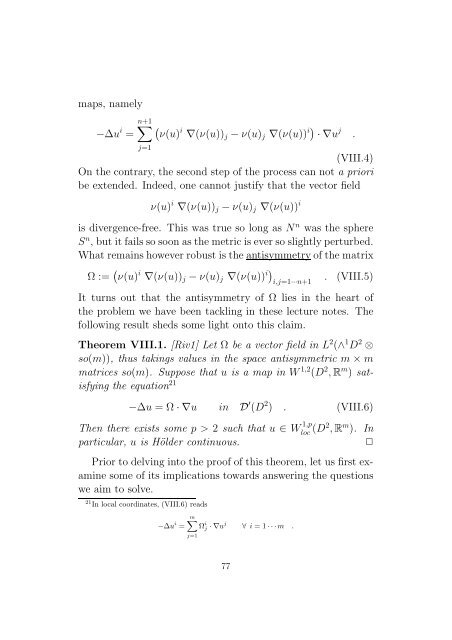Conformally Invariant Variational Problems. - SAM
Conformally Invariant Variational Problems. - SAM
Conformally Invariant Variational Problems. - SAM
You also want an ePaper? Increase the reach of your titles
YUMPU automatically turns print PDFs into web optimized ePapers that Google loves.
maps, namely<br />
∑n+1<br />
(<br />
−∆u i = ν(u) i ∇(ν(u)) j −ν(u) j ∇(ν(u)) i)·∇u j .<br />
j=1<br />
(VIII.4)<br />
On the contrary, the second step of the process can not a priori<br />
be extended. Indeed, one cannot justify that the vector field<br />
ν(u) i ∇(ν(u)) j −ν(u) j ∇(ν(u)) i<br />
is divergence-free. This was true so long as N n was the sphere<br />
S n , butitfailssosoonasthemetriciseversoslightlyperturbed.<br />
What remainshoweverrobustisthe antisymmetryofthe matrix<br />
Ω := ( ν(u) i ∇(ν(u)) j −ν(u) j ∇(ν(u)) i) i,j=1···n+1<br />
. (VIII.5)<br />
It turns out that the antisymmetry of Ω lies in the heart of<br />
the problem we have been tackling in these lecture notes. The<br />
following result sheds some light onto this claim.<br />
Theorem VIII.1. [Riv1] Let Ω be a vector field in L 2 (∧ 1 D 2 ⊗<br />
so(m)), thus takings values in the space antisymmetric m × m<br />
matrices so(m). Suppose that u is a map in W 1,2 (D 2 ,R m ) satisfying<br />
the equation 21<br />
−∆u = Ω·∇u in D ′ (D 2 ) . (VIII.6)<br />
Then there exists some p > 2 such that u ∈ W 1,p<br />
loc (D2 ,R m ). In<br />
particular, u is Hölder continuous.<br />
✷<br />
Prior to delving into the proof of this theorem, let us first examine<br />
some of its implications towards answering the questions<br />
we aim to solve.<br />
21 In local coordinates, (VIII.6) reads<br />
−∆u i =<br />
m∑<br />
Ω i j ·∇u j ∀ i = 1···m .<br />
j=1<br />
77
















